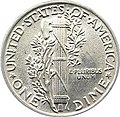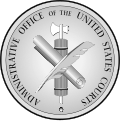Fasces: Difference between revisions
→Fasces in the United States: 71st Infantry Regiment (New York) to link page rather than US 71st infantry Regiment page which doesnt exist. |
→Origin and symbolism: Sentence on symbolism of "strength through unity" included |
||
| Line 4: | Line 4: | ||
==Origin and symbolism== |
==Origin and symbolism== |
||
The traditional [[ancient Rome|Roman]] ''fasces'' consisted of a bundle of [[Betula pubescens|birch]] rods, tied together with a red leather ribbon into a cylinder, and often including a bronze [[axe]] (or sometimes two) amongst the rods, with the blade(s) on the side, projecting from the bundle. They were carried by the [[lictor]]s who accompanied the [[Roman magistrate|magistrate]]s. The axe often represents the power over life or death through the death penalty, although after the [[Twelve Tables|laws of the twelve tables]], no Roman magistrate could summarily execute a Roman citizen.<ref>[http://www.livius.org/fa-fn/fasces/fasces.html Livius.org], fasces</ref> It was used as a symbol of the [[Roman Republic]] in many circumstances, including being carried in processions, much the way a flag might be carried today. |
The traditional [[ancient Rome|Roman]] ''fasces'' consisted of a bundle of [[Betula pubescens|birch]] rods, tied together with a red leather ribbon into a cylinder, and often including a bronze [[axe]] (or sometimes two) amongst the rods, with the blade(s) on the side, projecting from the bundle. They were carried by the [[lictor]]s who accompanied the [[Roman magistrate|magistrate]]s. The fasces was an ancient Roman symbol of the authority of magistrates and the symbolism of the fasces suggested strength through unity; a single rod is easily broken, while the bundle is very difficult to break. The axe often represents the power over life or death through the death penalty, although after the [[Twelve Tables|laws of the twelve tables]], no Roman magistrate could summarily execute a Roman citizen.<ref>[http://www.livius.org/fa-fn/fasces/fasces.html Livius.org], fasces</ref> It was used as a symbol of the [[Roman Republic]] in many circumstances, including being carried in processions, much the way a flag might be carried today. |
||
==Usage== |
==Usage== |
||
Revision as of 09:21, 19 October 2012

Fasces (/[invalid input: 'icon']ˈfæsiːz/, a plurale tantum, from the Latin word fascis, meaning "bundle")[1] are a bundle of wooden sticks with an axe blade emerging from the center, which is an image that traditionally symbolizes summary power and jurisdiction, and/or "strength through unity".[2] Fasces frequently occur as a charge in heraldry, and should not be confused with the related term, fess, which in French heraldry is called a fasce.
Origin and symbolism
The traditional Roman fasces consisted of a bundle of birch rods, tied together with a red leather ribbon into a cylinder, and often including a bronze axe (or sometimes two) amongst the rods, with the blade(s) on the side, projecting from the bundle. They were carried by the lictors who accompanied the magistrates. The fasces was an ancient Roman symbol of the authority of magistrates and the symbolism of the fasces suggested strength through unity; a single rod is easily broken, while the bundle is very difficult to break. The axe often represents the power over life or death through the death penalty, although after the laws of the twelve tables, no Roman magistrate could summarily execute a Roman citizen.[3] It was used as a symbol of the Roman Republic in many circumstances, including being carried in processions, much the way a flag might be carried today.
Usage
The term is related to the modern Italian word fascio, used in the 20th century to designate peasant cooperatives and industrial workers' unions.
Numerous governments and other authorities have used the image of the fasces for a symbol of power since the end of the Roman Empire. It has also been used to hearken back to the Roman republic, particularly by those who see themselves as modern-day successors to the old republic and/or its ideals. Italian Fascism, which derives its name from the fasces, arguably used this symbolism the most in the 20th century. The British Union of Fascists also used it in the 1930s. However, the fasces, as a widespread and long-established symbol in the West, has avoided the stigma associated with much of fascist symbolism, and many authorities continue to display them, including the federal government of the United States.
Antiquity
The fasces lictoriae ("bundles of the lictors") symbolised power and authority (imperium) in ancient Rome. A corps of apparitores (subordinate officials) called 'lictors' each carried fasces as a sort of staff of office before a magistrate, in a number corresponding to his rank, in public ceremonies and inspections. Bearers of fasces preceded consuls (and proconsuls), praetors (and propraetors), dictators, curule aediles and the Flamen Dialis. During triumphs (public celebrations held in Rome after a military conquest) heroic soldiers—those who had suffered injury in battle—carried fasces in procession.
Roman historians recalled that twelve lictors had ceremoniously accompanied the Etruscan kings of Rome in the distant past, and sought to account for the number and to provide etymologies for the name lictor.
Fasces-symbolism might derive—via the Etruscans—from the eastern Mediterranean, with the labrys, the Anatolian and Minoan double-headed axe, later incorporated into the praetorial fasces. There is little archaeological evidence.[4]
Traditionally, fasces carried within the Pomerium—the limits of the sacred inner city of Rome—had their axe blades removed. This signified that under normal political circumstances, the imperium-bearing magistrates did not have the judicial power of life and death; within the city, that power rested with the people through the assemblies. However, during times of emergencies when the Roman Republic declared a dictatorship (dictatura), lictors attending to the dictator kept the axe-blades even inside the Pomerium—a sign that the dictator had the ultimate power in his own hands. But in 48 BC, guards holding bladed fasces guided Vatia Isauricus to the tribunal of Marcus Caelius, and Vatia Isauricus used one to destroy Caelius's magisterial chair (sella curulis).
Fasces in the United States

Several offices and institutions in the United States have incorporated representations of the fasces into their iconography.
- In the Oval Office, above the door leading to the exterior walkway, and above the corresponding door on the opposite wall, which leads to the President's private office. Note: the fasces depicted have no axes, possibly because in the Roman Republic, the blade was always removed from the bundle whenever the fasces were carried inside the city, in order to symbolize the rights of citizens against arbitrary state power (see above).
- The grand seal of Harvard University inside Memorial Church is flanked by two inward-pointing fasces. The seal is located directly below the 112 m (368 ft) steeple and the Great Seal of the United States inside the Memorial Room. The walls of the room list the names of Harvard students, faculty, and alumni that gave their lives in service of the United States during World War I along with an empty tomb depicting Alma Mater holding a slain Harvard student.
- The National Guard uses the fasces on the seal of the National Guard Bureau, and it appears in the insignia of Regular Army officers assigned to National Guard liaison and in the insignia and unit symbols of National Guard units themselves. For instance, the regimental crest of the 71st Infantry Regiment (New York) of the New York National Guard consisted of a gold fasces set on a blue background.
- The reverse of the United States "Mercury" dime (minted from 1916 to 1945) bears the design of a fasces and an olive branch.
- Two fasces appear on either side of the flag of the United States behind the podium in the United States House of Representatives, representing the Roman power over the House and the country.
- The Mace of the United States House of Representatives, designed to resemble fasces, consists of thirteen ebony rods bound together in the same fashion as the fasces, topped by a silver eagle on a globe.
- The official seal of the United States Senate has as one component a pair of crossed fasces.
- Fasces ring the base of the Statue of Freedom atop the United States Capitol building.
- A frieze on the facade of the United States Supreme Court building depicts the figure of a Roman centurion holding a fasces, to represent "order".[5]
- The main entrance hallways in the Wisconsin State Capitol have lamps which are decorated with stone fasces motifs.
- At the Lincoln Memorial, Lincoln's seat of state bears the fasces—without axes—on the fronts of its arms. (Fasces also appear on the pylons flanking the main staircase leading into the memorial.)
- The official seal of the United States Tax Court bears the fasces at its center.
- Four fasces flank the two bronze plaques on either side of the bust of Lincoln memorializing his Gettysburg Address at Gettysburg, Pennsylvania.
- The fasces appears on the state seal of Colorado, USA, beneath the "All-seeing eye" (or Eye of Providence) and above the mountains and mines.
- The hallmark of the Kerr & Co silver company was a fasces.
- On the seal of the New York City borough of Brooklyn, a figure carries a fasces; the seal appears on the borough flag. Fasces can also be seen in the stone columns at Grand Army Plaza.
- Used as part of the Knights of Columbus emblem (designed in 1883).
- Many local police departments use the fasces as part of their badges and other symbols. For instance, the top border of the Los Angeles Police Department badge features a fasces. (1940)
- Commercially, a small fasces appeared at the top of one of the insignia of the Hupmobile car.
- A fasces appears on the statue of George Washington, made by Jean-Antoine Houdon which is now in the Virginia State Capital
- Columns in the form of fasces line the entrance to Buffalo City Hall.
- VAW-116 have a fasces on their unit insignia
- San Francisco's Coit Tower has two fasces-like insignia (without the axe) carved above its entrance, flanking a Phoenix.
- The seal of the United States Courts Administrative Office
- In the Washington Monument, there is a statue of George Washington leaning on a fasces
- A fasces is a common element in US Army Military Police heraldry, most visibly on the shoulder sleeve insignia of the 18th Military Police Brigade and the 42nd Military Police Brigade.
-
US "Mercury" dime reverse.
-
The Mace of the United States House of Representatives, designed to resemble fasces.
-
The seal of the Senate. Note the crossed fasces at the bottom.
-
The Lincoln Memorial with the fronts of the chair's arms shaped to resemble fasces
-
The emblem of the Knights of Columbus
-
The seal of the Administrative Office of the United States Courts.
-
Above the door to Chicago's City Hall
-
Shoulder Sleeve Insignia of the 18th MP Brigade
-
Shoulder Sleeve Insignia of the 42nd MP Brigade
-
Statue of George Washington at the site of his inauguration as first president of the United States, now occupied by Federal Hall National Memorial, includes a fasces to the subject's rear right.
Fasces in France

A review of the images included in Les Grands Palais de France Fontainebleau [6][7] reveals that French architects used the Roman fasces (faisceaux romains) as a decorative device as early as the reign of Louis XIII (1610–1643) and continued to employ it through the periods of Napoleon I's Empire (1804–1815).
The fasces typically appeared in a context reminiscent of the Roman Republic and/or of the Roman Empire. The French Revolution has used many references to the ancient Roman Republic in its imagery. During the First Republic, topped by the Phrygian cap, the fasces is a tribute to the Roman Republic and means that power belongs to the people. It also symbolizes the "unity and indivisibility of the Republic",[8] as stated in the French Constitution. In 1848 and after 1870, it appears on the seal of the French Republic, held by Liberty. There is always the fasces in the arms of the French Republic with the "RF" for République française (see image below), surrounded by leaves of olive tree (as a symbol of peace) and oak (as a symbol of justice). While it is widely used by French officials, this symbol never was officially adopted by the government.[9]
The fasces appears on the helmet and the buckle insignia of the French Army's Autonomous Corps of Military Justice, as well as on that service's distinct cap badges for the prosecuting and defending lawyers in a court-martial.[citation needed]
Other modern authorities and movements




The following cases all involve the adoption of the fasces as a symbol or icon; no actual physical re-introduction has occurred.
- Aiguillettes worn by aides-de-camp in many Commonwealth armed forces bear the fasces on the metal points; the origin of this is unknown, as the fasces is an uncommon symbol in British/Commonwealth heraldry and insignia.
- Napoleon and the French Revolution; this emblem remains on the front cover of French passports and as part of the French coat of arms
- The Spanish gendarmerie Guardia Civil
- Both the Norwegian and Swedish Police Service have double fasces in their logos.
- The Miners Flag (also known as the "Diggers' Banner"), the standard of 19th-century gold-miners in the colony of Victoria, in Australia, included the fasces as a symbol of unity and strength of common purpose. This flag symbolized the movement prior to the rebellion at the Eureka Stockade (1854).
- The coat of arms of Ecuador, which also features on its national flag, has included a fasces since 1822.
- The coat of arms of Cameroon features two fasces which form a diagonal cross.
- The coat of arms of Cuba features a fasces.
- The third flag of Gran Colombia, a former nation in South America, depicted a large fasces entwined with several arrows.
- The coat of arms of Norte de Santander, a department of Colombia, and of its capital Cúcuta, both feature a fasces.
- The Grand Coat of Arms of Vilnius, Lithuania features a fasces.
- The crest of the fraternity Alpha Phi Delta displays the fasces in its heraldry.
- The crest of the Chi Phi Fraternity features a fasces.
- The symbol of the National Party (Uruguay) (Partido Nacional)
- On the entrance of the Royal Castle of Laeken in Belgium
Sources
- Tassi Scandone Elena, Verghe, scuri e fasci littori in Etruria - Contributo allo studio degli insignia imperii. Volume n. 36 della Biblioteca di Studi Etruschi dell'Istituto Nazionale di Studi Etruschi ed Italici, Istituti Editoriali e Poligrafici Internazionali, Pisa - Roma, 2001. ISBN 88-8147-263-5. Pp. 272, con VII tavv. f.t.
- Salvatori Paola S., L’adozione del fascio littorio nella monetazione dell’Italia fascista, in «Rivista italiana di numismatica e scienze affini», CIX, 2008, pp. 333–352.
See also
- Faggot (bundle of sticks)
- Fascine
- Fascio (usage 1890s to World War I)
- Ferula
- Francisca
- Labrys
- Staff of office
Notes
- ^ Merriam-Webster Online Dictionary: fasces
- ^ Fascio
- ^ Livius.org, fasces
- ^ "Fasces". 2011-03-26. Retrieved 2011-04-13.
- ^ The Supreme Court Historical Society
- ^ Les Grands Palais de France Fontainebleau , I re Série, Styles Louis XV, Louis XVI, Empire, Labrairie Centrale D'Art Et D'Architecture, Ancienne Maison Morel, Ch. Eggimann, Succ, 106, Boulevard Saint Germain, Paris, 1910
- ^ Les Grands Palais de France : Fontainebleau , II me Série, Les Appartments D'Anne D'Autriche, De François I er, Et D'Elenonre La Chapelle, Labrairie Centrale D'Art Et D'Architecture, Ancienne Maison Morel, Ch. Eggimann, Succ, 106, Boulevard Saint Germain, Paris, 1912
- ^ Site of the French Presidency
- ^ Site of the French Presidency








